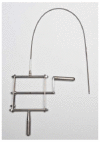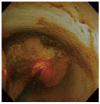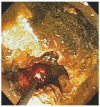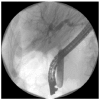Endoscopic management of difficult common bile duct stones
- PMID: 23345939
- PMCID: PMC3547556
- DOI: 10.3748/wjg.v19.i2.165
Endoscopic management of difficult common bile duct stones
Abstract
Endoscopy is widely accepted as the first treatment option in the management of bile duct stones. In this review we focus on the alternative endoscopic modalities for the management of difficult common bile duct stones. Most biliary stones can be removed with an extraction balloon, extraction basket or mechanical lithotripsy after endoscopic sphincterotomy. Endoscopic papillary balloon dilation with or without endoscopic sphincterotomy or mechanical lithotripsy has been shown to be effective for management of difficult to remove bile duct stones in selected patients. Ductal clearance can be safely achieved with peroral cholangioscopy guided laser or electrohydraulic lithotripsy in most cases where other endoscopic treatment modalities have failed. Biliary stenting may be an alternative treatment option for frail and elderly patients or those with serious co morbidities.
Keywords: Choledocholithiasis; Difficult to remove biliary stones; Electrohydra-ulic lithotripsy; Endoscopic large balloon papillary dilation; Laser lithotripsy; Mechanical lithotripsy; Peroral cholangioscopy.
Figures





Similar articles
-
[Single-operator Cholangioscopy Guided Lithotripsy].Korean J Gastroenterol. 2022 Oct 25;80(4):163-168. doi: 10.4166/kjg.2022.117. Korean J Gastroenterol. 2022. PMID: 36281548 Review. Korean.
-
Alternative methods in the endoscopic management of difficult common bile duct stones.Dig Endosc. 2010 Jul;22 Suppl 1:S79-84. doi: 10.1111/j.1443-1661.2010.00960.x. Dig Endosc. 2010. PMID: 20590778 Review.
-
Endoscopic management of bile duct stones.Dig Endosc. 2010 Jul;22 Suppl 1:S69-75. doi: 10.1111/j.1443-1661.2010.00953.x. Dig Endosc. 2010. PMID: 20590776 Review.
-
Recent advances in the management of difficult bile-duct stones: a focus on single-operator cholangioscopy-guided lithotripsy.Korean J Intern Med. 2021 Mar;36(2):235-246. doi: 10.3904/kjim.2020.425. Epub 2020 Dec 1. Korean J Intern Med. 2021. PMID: 32972127 Free PMC article. Review.
-
Endoscopic treatment of difficult common bile duct stones.Dig Endosc. 2010 Jul;22 Suppl 1:S90-7. doi: 10.1111/j.1443-1661.2010.00979.x. Dig Endosc. 2010. PMID: 20590781 Review.
Cited by
-
National Survey Regarding the Management of Difficult Bile Duct Stones in South Korea.Gut Liver. 2023 May 15;17(3):475-481. doi: 10.5009/gnl220117. Epub 2022 Jul 19. Gut Liver. 2023. PMID: 35851040 Free PMC article.
-
Complex biliary stones management: cholangioscopy versus papillary large balloon dilation - a randomized controlled trial.Endosc Int Open. 2018 Feb;6(2):E131-E138. doi: 10.1055/s-0043-122493. Epub 2018 Feb 1. Endosc Int Open. 2018. PMID: 29399609 Free PMC article.
-
Endoscopic sphincterotomy vs papillary large balloon dilation vs combination modalities for large common bile duct stones: a network meta-analysis.Endosc Int Open. 2022 Dec 15;10(12):E1599-E1607. doi: 10.1055/a-1958-2348. eCollection 2022 Dec. Endosc Int Open. 2022. PMID: 36531684 Free PMC article. Review.
-
Endoscopic Management of Difficult Bile Duct Stones.Curr Gastroenterol Rep. 2018 Mar 23;20(2):8. doi: 10.1007/s11894-018-0613-1. Curr Gastroenterol Rep. 2018. PMID: 29572696 Review.
-
Outcome of stenting in biliary and pancreatic benign and malignant diseases: A comprehensive review.World J Gastroenterol. 2015 Aug 14;21(30):9038-54. doi: 10.3748/wjg.v21.i30.9038. World J Gastroenterol. 2015. PMID: 26290631 Free PMC article. Review.
References
-
- Samardzic J, Latic F, Kraljik D, Pitlovic V, Mrkovic H, Miskic D, Latic A, Delibegovic S. Treatment of common bile duct stones--is the role of ERCP changed in era of minimally invasive surgery? Med Arh. 2010;64:187–188. - PubMed
Publication types
MeSH terms
LinkOut - more resources
Full Text Sources
Other Literature Sources
Medical

